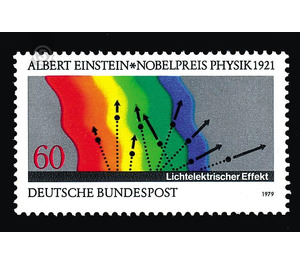Nobel laureate of physics and chemistry - Germany / Federal Republic of Germany 1979 - 60 Pfennig
Theme: Post & Philately
| Country | Germany / Federal Republic of Germany |
| Issue Date | 1979 |
| Face Value | 60.00 |
| Color | multi-colored |
| Perforation | K 14:14 1/4 |
| Printing Type | 4-color rotogravure |
| Stamp Type | Postage stamp |
| Item Type | Stamp |
| Chronological Issue Number | 906 |
| Chronological Chapter | GER-BRD |
| SID | 616291 |
| In 43 Wishlists | |
The special stamp series honors Nobel Prize winners Albert Einstein, Otto Hahn and Max von Laue. The Nobel Prize-winning works of the three scientists provided the motifs of the three commemorative stamps. Albert Einstein was born on March 14, 1879 in Ulm. After studying physics in Zurich, he had worked at the Patent Office in Bern since 1902 and published three groundbreaking works in 1905. Einstein succeeded in interpreting the external photoelectric effect, and in 1921 he received the Nobel Prize for Physics. As part of this work Einstein made the assumption that the light not only wave nature, but at the same time also particle character. Einstein also published the basics of the special theory of relativity in 1905 and concluded a little later that mass and energy correspond to one another: E = mc2. Einstein formulated general relativity from 1914 to 1916. From 1914 to 1933 Einstein was a member of the Prussian Academy of Sciences and at the same time director of the Kaiser Wilhelm Institute for Physics. In 1933 Einstein emigrated to the United States and worked at the Institute for Advanced Study at Princeton (N.J.) until his death on April 18, 1955.


